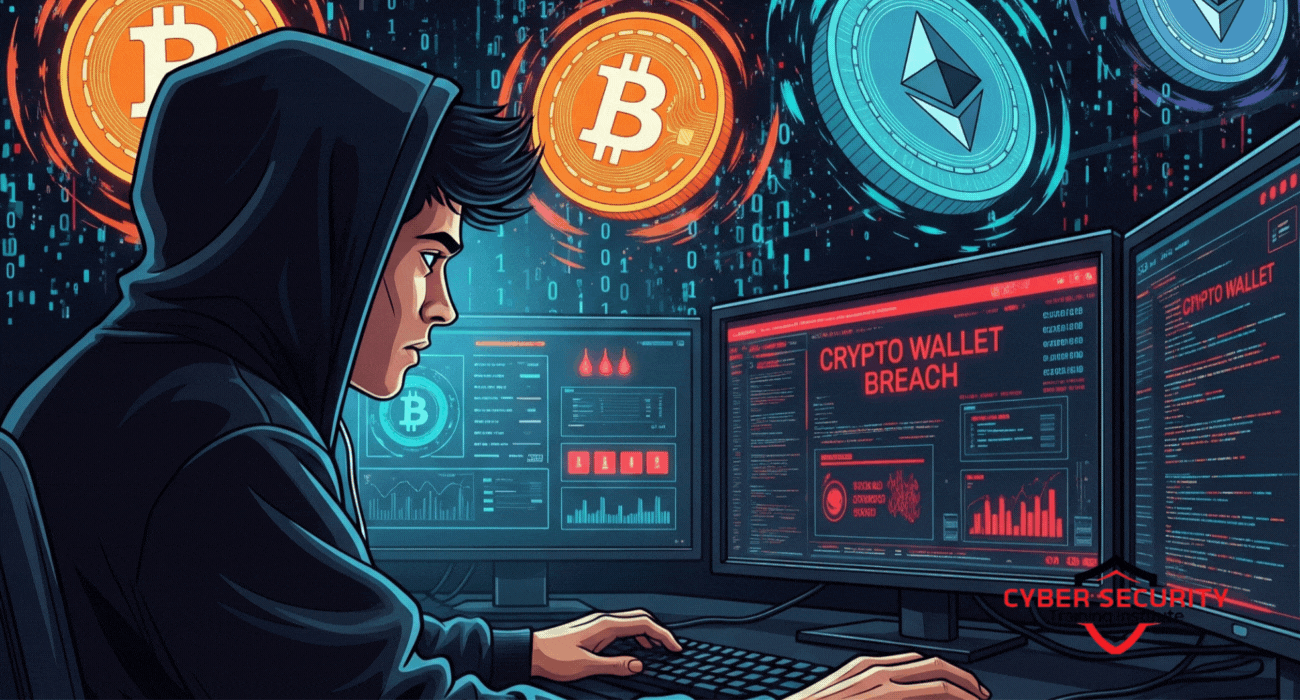Cybersecurity Lessons from the Latest Crypto Exchange Hacks
Cryptocurrency exchanges have become prime targets for cybercriminals, with billions of dollars stolen in high-profile hacks over the years. Each breach exposes vulnerabilities that shake user trust and highlight the need for stronger cybersecurity measures. From phishing scams to sophisticated exploits of exchange infrastructure, these incidents offer critical lessons for exchanges, users, and the broader digital asset ecosystem. In this blog, we’ll dive into recent crypto exchange hacks, break down what went wrong, and share practical steps to enhance security. Whether you’re a crypto enthusiast or a beginner, this guide will help you understand how to stay safe in the ever-evolving world of digital currencies.

Table of Contents
- Major Crypto Exchange Hacks in 2024–2025
- Common Vulnerabilities Exploited
- Key Cybersecurity Lessons
- How Users Can Protect Themselves
- What Exchanges Must Do
- Conclusion
- Frequently Asked Questions
Major Crypto Exchange Hacks in 2024–2025
The past couple of years have seen some of the largest crypto exchange hacks in history, with attackers exploiting both technical and human weaknesses. Below is a table summarizing key incidents, their methods, and the lessons they underscore.
| Exchange | Date | Amount Stolen | Method | Key Lesson |
|---|---|---|---|---|
| Bybit | Feb 2025 | $1.4B (400,000 ETH) | Cold wallet software exploit | Secure cold storage and multi-signature protocols are critical. |
| DMM Bitcoin | May 2024 | $305M (4,502.9 BTC) | Private key compromise | Private key security must be prioritized. |
| WazirX | Sep 2024 | $230M | Malicious smart contract upgrade | Thoroughly vet smart contract updates. |
| CoinDCX | Jul 2025 | $44M | Server-side breach | Strengthen server security and monitoring. |
| Nobitex | Jun 2025 | $90M | Stolen private keys and admin credentials | Limit access to sensitive credentials. |
These hacks reveal a range of attack methods, from exploiting software vulnerabilities to targeting human error, emphasizing the need for comprehensive security strategies.
Common Vulnerabilities Exploited
Hackers exploit a variety of weaknesses in crypto exchanges. Understanding these vulnerabilities is the first step to preventing future breaches.
- Hot Wallet Vulnerabilities: Hot wallets, which are connected to the internet for quick transactions, are prime targets. For example, Coincheck’s 2018 hack saw $534M in NEM tokens stolen due to inadequate hot wallet security, like the lack of multi-signature protection.
- Private Key Compromises: Private keys are like the passwords to your crypto. If stolen, hackers gain full access. The DMM Bitcoin hack in 2024 involved compromised private keys, leading to a $305M loss.
- Phishing and Social Engineering: Hackers trick employees or users into revealing sensitive information. Coinbase’s 2025 breach involved hackers paying off employees to access customer data.
- Smart Contract Flaws: WazirX’s $230M hack in 2024 stemmed from a malicious smart contract update, showing how even automated systems can be exploited if not carefully audited.
- Server-Side Breaches: CoinDCX’s 2025 hack involved a server breach, highlighting the need for robust server security and real-time monitoring.
Key Cybersecurity Lessons
Each hack provides valuable insights into improving cybersecurity. Here are the top lessons:
- Implement Multi-Signature Wallets: Multi-signature (multisig) wallets require multiple approvals for transactions, reducing the risk of unauthorized access. Exchanges like Binance have adopted multisig to enhance security.
- Prioritize Cold Storage: Storing most assets in offline cold wallets, as Nobitex did post-hack, minimizes exposure to online threats.
- Conduct Regular Security Audits: Regular audits of code, smart contracts, and infrastructure can catch vulnerabilities before hackers do. WazirX’s hack could have been prevented with thorough smart contract vetting.
- Educate Employees and Users: Phishing attacks succeed because of human error. Training on recognizing suspicious emails or links, as suggested after Coinbase’s breach, is essential.
- Enhance Real-Time Monitoring: CoinDCX’s server breach underscores the need for systems that detect and respond to unusual activity instantly.
- Limit Access to Sensitive Systems: Nobitex’s hack showed how compromised admin credentials can lead to disaster. Restricting access to critical systems is a must.
How Users Can Protect Themselves
While exchanges bear much of the responsibility, users also play a crucial role in securing their assets. Here’s how you can stay safe:
- Use Hardware Wallets: Hardware wallets, like Ledger or Trezor, store your crypto offline, making them immune to online hacks.
- Enable Two-Factor Authentication (2FA): Use apps like Google Authenticator instead of SMS-based 2FA, which can be intercepted.
- Beware of Phishing: Never click links in unsolicited emails or messages. Always verify the website’s URL before logging in.
- Research Exchanges: Choose exchanges with strong security track records, like those using multisig wallets and cold storage.
- Monitor Your Accounts: Regularly check your account for suspicious activity and report anything unusual immediately.
What Exchanges Must Do
Exchanges are the gatekeepers of the crypto world and must lead the charge in cybersecurity. Here’s what they should focus on:
- Adopt Advanced Security Protocols: Implement multisig wallets, encrypt sensitive data, and use secure APIs, as recommended by experts after the Bybit hack.
- Invest in Cybersecurity Teams: Large exchanges need dedicated security teams, as suggested by Halborn’s COO, to stay ahead of threats.
- Offer Insurance Funds: Binance’s SAFU fund is a model for reimbursing users after hacks, building trust and resilience.
- Collaborate with Authorities: Working with blockchain analytics firms and law enforcement, as Nobitex did, can help trace stolen funds.
- Communicate Transparently: Promptly informing users about breaches, like Coinbase did in 2025, maintains trust and encourages vigilance.
Conclusion
Crypto exchange hacks, like those of Bybit, DMM Bitcoin, WazirX, CoinDCX, and Nobitex, reveal the ongoing battle between cybercriminals and the digital asset industry. These incidents highlight vulnerabilities in hot wallets, private keys, smart contracts, and server infrastructure, but they also offer a roadmap for improvement. By adopting multisig wallets, prioritizing cold storage, conducting regular audits, and educating users, exchanges can build a more secure ecosystem. Users, too, must take responsibility by using hardware wallets, enabling 2FA, and staying vigilant against phishing. As the crypto world grows, so do the stakes, making it critical for everyone involved to learn from past mistakes and stay one step ahead of hackers. By applying these lessons, we can create a safer future for cryptocurrency trading.
Frequently Asked Questions
What is a crypto exchange hack?
A crypto exchange hack is an unauthorized breach where hackers steal digital assets from an exchange’s wallets or user accounts, often exploiting technical or human vulnerabilities.
Why are crypto exchanges targeted by hackers?
Exchanges hold large amounts of valuable cryptocurrencies, making them lucrative targets for cybercriminals seeking quick profits.
What are hot wallets?
Hot wallets are online storage systems for cryptocurrencies, used for quick transactions but vulnerable to hacks due to their internet connection.
What are cold wallets?
Cold wallets are offline storage devices, like hardware wallets, that protect cryptocurrencies from online threats.
How do hackers steal private keys?
Hackers may use phishing, malware, or social engineering to trick users or employees into revealing private keys, which control access to crypto funds.
What is a multi-signature wallet?
A multi-signature wallet requires multiple approvals for transactions, adding an extra layer of security against unauthorized access.
Why are phishing attacks so common in crypto hacks?
Phishing exploits human error by tricking users into sharing sensitive information, making it an easy and effective attack method.
How can I protect my crypto from hacks?
Use hardware wallets, enable 2FA, avoid suspicious links, and choose reputable exchanges with strong security measures.
What is two-factor authentication (2FA)?
2FA adds a second verification step, like a code from an app, to ensure only you can access your account.
Can stolen crypto be recovered?
Recovery is difficult, especially if funds are moved through mixers, but blockchain analytics and law enforcement can sometimes help, as seen in the KuCoin hack.
What is a smart contract?
A smart contract is a self-executing program on a blockchain that automates transactions but can be exploited if not properly audited.
How do exchanges secure user funds?
Exchanges use cold storage, multisig wallets, encryption, and insurance funds like Binance’s SAFU to protect user assets.
What role do security audits play?
Regular audits of code and infrastructure identify vulnerabilities before hackers can exploit them, preventing breaches like WazirX’s.
Why do exchanges use hot wallets if they’re risky?
Hot wallets enable fast transactions, which are necessary for user convenience, but they must be secured with multisig and monitoring.
What is social engineering in hacking?
Social engineering involves manipulating people into revealing sensitive information, often through phishing or impersonation, as in Coinbase’s 2025 breach.
How do I spot a phishing email?
Look for suspicious sender addresses, urgent language, or requests for sensitive information. Always verify the source before clicking links.
Are decentralized exchanges (DEXs) safer than centralized ones?
DEXs can be safer since users control their keys, but they face risks like smart contract exploits, as seen in DeFi hacks.
What happens to an exchange after a hack?
Exchanges may halt trading, reimburse users, improve security, or shut down, as DMM Bitcoin plans to do by March 2025.
Can I trust crypto exchanges?
Choose exchanges with strong security, transparency, and insurance funds. Research their track record before investing.
How can exchanges prevent future hacks?
By using multisig wallets, cold storage, regular audits, employee training, and real-time monitoring, exchanges can reduce risks.
What's Your Reaction?
 Like
0
Like
0
 Dislike
0
Dislike
0
 Love
0
Love
0
 Funny
0
Funny
0
 Angry
0
Angry
0
 Sad
0
Sad
0
 Wow
0
Wow
0
















